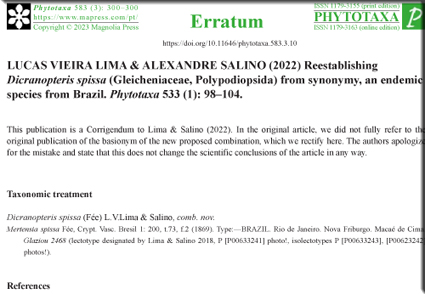Abstract
This publication is a Corrigendum to Lima & Salino (2022). In the original article, we did not fully refer to the original publication of the basionym of the new proposed combination, which we rectify here. The authors apologize for the mistake and state that this does not change the scientific conclusions of the article in any way.
References
<p>Fée, A.L.A. (1869) <em>Cryptogames vasculaires (fougères, Lycopodiacées, hydropteridées, equisétacées) du Brésil</em>. Pars 1. J.-B. Baillière, Paris, pp. [i]–xvi, [1]–267, pl. 1–78.</p>
<p>Lima, L.V. & Salino, A. (2018) The fern family Gleicheniaceae (Polypodiopsida) in Brazil. <em>Phytotaxa</em> 358 (3): 199–234. https://doi.org/10.11646/phytotaxa.358.3.1</p>
<p>Lima, L.V. & Salino, A. (2022) Reestablishing <em>Dicranopteris spissa</em> (Gleicheniaceae, Polypodiopsida) from synonymy, an endemic species from Brazil. <em>Phytotaxa</em> 533 (1): 98–104. https://doi.org/10.11646/phytotaxa.533.1.7</p>
<p>Lima, L.V. & Salino, A. (2018) The fern family Gleicheniaceae (Polypodiopsida) in Brazil. <em>Phytotaxa</em> 358 (3): 199–234. https://doi.org/10.11646/phytotaxa.358.3.1</p>
<p>Lima, L.V. & Salino, A. (2022) Reestablishing <em>Dicranopteris spissa</em> (Gleicheniaceae, Polypodiopsida) from synonymy, an endemic species from Brazil. <em>Phytotaxa</em> 533 (1): 98–104. https://doi.org/10.11646/phytotaxa.533.1.7</p>


